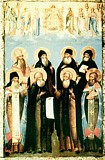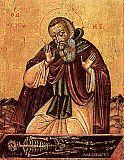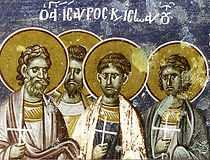

| Previous day | Next day |
| Old Style
July 6
|
Tuesday |
New Style
July 19
|
| 6th Week after Pentecost. Tone 4. | No fast.
|
![]() St. Sisoes the Great, of Egypt (429).
St. Sisoes the Great, of Egypt (429). ![]() Synaxis of the Saints of Radonezh.
Synaxis of the Saints of Radonezh.
Martyrs Marinus and Martha, their children Audifax and Abbacum (Habakkuk), and those with them at Rome: Cyrinus, the priest Valentine, and Asterius (269). St. Cointus (Quintus) of Phrygia, confessor and wonderworker (ca. 283). Virgin-martyr Lucy, Martyr Rixius, and those with them at Rome: Martyrs Anthony, Lucian, Isidore, Dion, Diodorus, Cutonius, Arnosus, Capicus, Satyrus, and others (301). Hieromartyr Isaurus, deacon, and Martyrs Innocent, Felix, Hermias, Basil, Peregrinus, Rufus, and Rufinus, of Apollonia in Macedonia (284). St. Sisoes of the Kiev Caves (13th c.). Uncovering of the relics of St. Juliana, princess of Olshansk (16th c). St. Gleb Vsevolodovich, prince of Gorodno (ca. 1170). St. Barnabas, elder, of the Gethsemane Skete of St. Sergius Lavra (1906).
New Hieromartyrs Euthymius (Lyubovichev), hieromonk of Optina Monastery (1931), and Theodore (Bogoyavlensky), hieromonk, of Vostryakovo (Moscow) (1943).
Hieromartyr Astius, bishop of Dyrrachium in Macedonia (ca. 100). St. Monenna, foundress of Killeevy Monastery (Ireland) (ca. 518). St. Goar, hieromonk, hermit, and missionary along the Rhine (Germany) (649). New Monk-martyr Cyril of Hilandar, Mt. Athos, at Thessalonica (1566). Apostles of the Seventy Archippus, Philemon, and Onesimus (1st c.).
Repose of Archimandrite Arsenius (Papacioc) of Romania (2011).
Thoughts for Each Day of the Year
According to the Daily Church Readings from the Word of God
By St. Theophan the Recluse

Tuesday. [I Cor. 1:1-9; Matt. 13:24-30]
The good seed was sown, but the enemy came and sowed tares among the wheat. The tares in the Church are heresies and schisms, and in each of us they are bad thoughts, feelings, desires, and passions. A person accepts the good seed of the word of God, decides to live in a holy way, and begins to live in this way. When such a person falls asleep, that is, when his attention toward himself weakens, then the enemy of salvation comes and places evil ideas in him, which if not rejected at the start ripen into desires and dispositions, introducing their own spheres of activity, which mix themselves in with good deeds, feelings and thoughts. Both remain together this way until the harvest. This harvest is repentance. The Lord sends the angels—a feeling of contrition and the fear of God, and they come in like a sickle, then burn up all the tares in a fire of painful self-condemnation. Pure wheat remains in the grain-house of the heart, to the joy of the man, the angels, and the most Good God worshipped in the Trinity.


